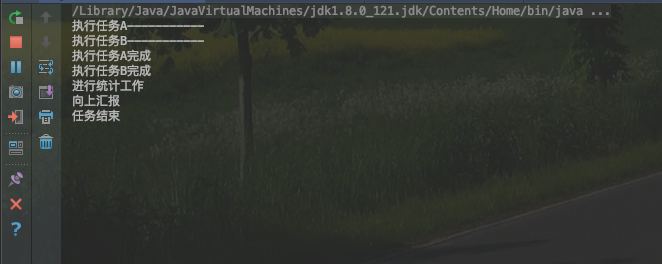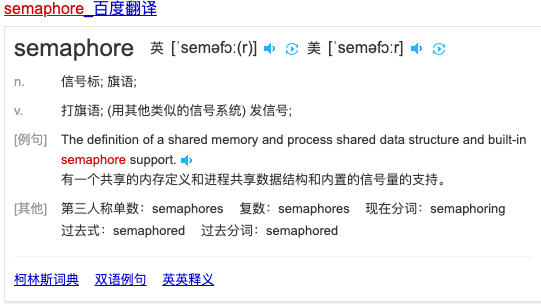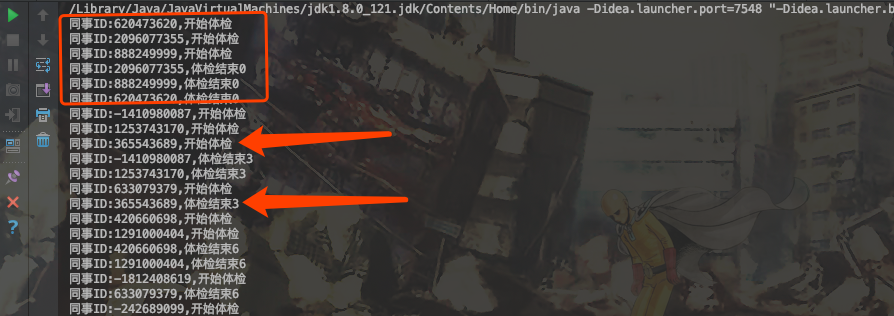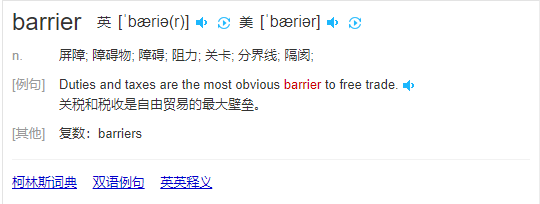一、CountDownLatch
文档描述
A synchronization aid that allows one or more threads to wait until* a set of operations being performed in other threads completes.
是一个同步帮助工具,允许一个或多个线程等待一系列其他线程操作完后,再执行。
count down 倒计时
latch 插锁
在Java中Latch结尾的也叫 闭锁

用法
| 方法名 | 作用 |
|---|---|
| await() | 线程会被挂起,它会等待直到count值为0才继续执行 |
简单示例
public class CountDownLatchDemo {
private static final ExecutorService threadPool = new ThreadPoolExecutor(50, 100,
5, TimeUnit.SECONDS,
new SynchronousQueue<>(),
new BasicThreadFactory.Builder().namingPattern("thread-%d").build());
public static void main(String[] args) throws InterruptedException {
CountDownLatch countDownLatch = new CountDownLatch(10);
for (int i = 1; i <= 10; i++) {
threadPool.execute(() -> {
System.out.println("test-"+new Random().nextInt());
countDownLatch.countDown();
});
}
countDownLatch.await();
System.out.println("end");
threadPool.shutdown();
}
}

应用场景
同事A需要执行任务A,进行A类数据的收集
同事B需要执行任务B,进行B类数据的收集
项目经理需要等到A和B的数据都收集齐之后,进行统计,然后向上汇报。
public class CountDownLatchDemo2 {
private static final ExecutorService threadPool = new ThreadPoolExecutor(50, 100,
5, TimeUnit.SECONDS,
new SynchronousQueue<>(),
new BasicThreadFactory.Builder().namingPattern("thread-%d").build());
public static void main(String[] args) {
CountDownLatch countDownLatch = new CountDownLatch(2);
// 收集数据A
threadPool.execute(new TaskA(countDownLatch));
// 收集数据B
threadPool.execute(new TaskB(countDownLatch));
try {
countDownLatch.await();
} catch (InterruptedException e) {
e.printStackTrace();
}
// 进行统计工作
System.out.println("进行统计工作");
// 向上汇报
System.out.println("向上汇报");
System.out.println("任务结束");
threadPool.shutdown();
}
static class TaskA implements Runnable {
private CountDownLatch countDownLatch;
public TaskA(CountDownLatch countDownLatch) {
this.countDownLatch = countDownLatch;
}
@Override
public void run() {
try {
System.out.println("执行任务A-----------");
TimeUnit.SECONDS.sleep(5);
System.out.println("执行任务A完成");
countDownLatch.countDown();
} catch (InterruptedException e) {
e.printStackTrace();
}
}
}
static class TaskB implements Runnable {
private CountDownLatch countDownLatch;
public TaskB(CountDownLatch countDownLatch) {
this.countDownLatch = countDownLatch;
}
@Override
public void run() {
try {
System.out.println("执行任务B-----------");
TimeUnit.SECONDS.sleep(7);
System.out.println("执行任务B完成");
countDownLatch.countDown();
} catch (InterruptedException e) {
e.printStackTrace();
}
}
}
}
运行结果

二、Semaphore

文档描述
A counting semaphore. Conceptually, a semaphore maintains a set of* permits. Each {@link #acquire} blocks if necessary until a permit is* available, and then takes it. Each {@link #release} adds a permit,* potentially releasing a blocking acquirer.* However, no actual permit objects are used; the {@code Semaphore} just* keeps a count of the number available and acts accordingly.**
Semaphores are often used to restrict the number of threads than can* access some (physical or logical) resource. For example, here is* a class that uses a semaphore to control access to a pool of items:
用于控制并发量。
用法
| 方法名 | 作用 |
|---|---|
| acquire() | 从该信号量获取一个许可,在获取许可前线程将一直阻塞 |
| release() | 释放一个许可,将其返回给信号量 |
简单示例
public class SemaphoreDemo {
private static final ExecutorService threadPool = new ThreadPoolExecutor(20, 100,
1, TimeUnit.MINUTES,
new SynchronousQueue<>(),
new BasicThreadFactory.Builder().namingPattern("thread-%d").build());
private static volatile int count = 0;
public static void main(String[] args) {
Semaphore semaphore = new Semaphore(3);
for (int i = 0; i < 100; i++) {
threadPool.execute(() -> {
try {
semaphore.acquire();
System.out.println("test--" + count);
try {
TimeUnit.SECONDS.sleep(3);
} catch (InterruptedException e) {
e.printStackTrace();
}
count++;
semaphore.release();
} catch (InterruptedException e) {
e.printStackTrace();
}
});
}
}
}

应用场景
公司有100个人需要体检,医院每次最多只能体检3人。
当有3个人在体检时,其他人只能等待,有1个人体检完,下一个人可以补上。
public class SemaphoreDemo {
private static final ExecutorService threadPool = new ThreadPoolExecutor(20, 100,
1, TimeUnit.MINUTES,
new SynchronousQueue<>(),
new BasicThreadFactory.Builder().namingPattern("thread-%d").build());
private static volatile int count = 0;
public static void main(String[] args) {
Semaphore semaphore = new Semaphore(3);
for (int i = 0; i < 100; i++) {
threadPool.execute(() -> {
try {
String id = new Random().nextInt() + "";
semaphore.acquire();
System.out.println("同事ID:" + id + ",开始体检");
try {
TimeUnit.SECONDS.sleep(3L);
TimeUnit.MILLISECONDS.sleep(new Random(10000).nextInt());
} catch (InterruptedException e) {
e.printStackTrace();
}
System.out.println("同事ID:" + id + ",体检结束" + count);
count++;
semaphore.release();
} catch (InterruptedException e) {
e.printStackTrace();
}
});
}
}
}
运行结果

三、CyclicBarrier
概念


和闭锁不同的是,栅栏是用来等待线程的,闭锁是用来等待时间。
当指定线程数都到达某个点,才开始执行后续的操作。
就好比有10个人赛跑,要跑400米,在100米设置一个栅栏,当这10个人都到达了这个栅栏的时候,才取消栅栏,全部放行。
简单示例
public class CyclicBarrierDemo {
private static final ExecutorService threadPool = new ThreadPoolExecutor(50, 100,
1, TimeUnit.MINUTES,
new SynchronousQueue<>(),
new BasicThreadFactory.Builder().namingPattern("thread-%d").build());
public static void main(String[] args) {
CyclicBarrier cyclicBarrier = new CyclicBarrier(10);
for (int i = 0; i < 10; i++) {
threadPool.execute(() -> {
System.out.println("线程" + Thread.currentThread().getId() + "跑到100米,遇到栅栏,停下");
try {
cyclicBarrier.await();
} catch (InterruptedException e) {
e.printStackTrace();
} catch (BrokenBarrierException e) {
e.printStackTrace();
}
System.out.println("继续跑完剩下300米");
});
}
threadPool.shutdown();
}
}

应用场景
还用上面CountDownLatch的例子,
同事A需要执行任务A,进行A类数据的收集
同事B需要执行任务B,进行B类数据的收集
项目经理需要等到A和B的数据都收集齐之后,进行统计,然后向上汇报。
public class CyclicBarrierDemo2 {
private static final ExecutorService threadPool = new ThreadPoolExecutor(50, 100,
5, TimeUnit.SECONDS,
new SynchronousQueue<>(),
new BasicThreadFactory.Builder().namingPattern("thread-%d").build());
private static volatile boolean flag = false;
public static void main(String[] args) {
CyclicBarrier cb = new CyclicBarrier(2);
// 收集数据A
threadPool.execute(new TaskA(cb));
// 收集数据B
threadPool.execute(new TaskB(cb));
threadPool.shutdown();
}
static class TaskA implements Runnable {
private CyclicBarrier cb;
public TaskA(CyclicBarrier cb) {
this.cb = cb;
}
@Override
public void run() {
try {
System.out.println("执行任务A-----------");
TimeUnit.SECONDS.sleep(5);
System.out.println("执行任务A完成");
cb.await();
if(!flag){
flag = true;
System.out.println("进行统计工作");
System.out.println("向上汇报");
}
} catch (InterruptedException e) {
e.printStackTrace();
} catch (BrokenBarrierException e) {
e.printStackTrace();
}
}
}
static class TaskB implements Runnable {
private CyclicBarrier cb;
public TaskB(CyclicBarrier cb) {
this.cb = cb;
}
@Override
public void run() {
try {
System.out.println("执行任务B-----------");
TimeUnit.SECONDS.sleep(7);
System.out.println("执行任务B完成");
cb.await();
if(!flag){
flag = true;
System.out.println("进行统计工作");
System.out.println("向上汇报");
System.out.println("任务结束");
}
} catch (InterruptedException e) {
e.printStackTrace();
} catch (BrokenBarrierException e) {
e.printStackTrace();
}
}
}
}
运行结果
